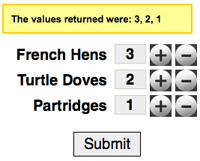JavaScript insertAdjacentHTML and beforeend
In case you didn't know: the damn DOM is slow. As we make our websites more dynamic and AJAX-based, we need to find ways of manipulating the DOM with as little impact on performance as possible. A while back I mentioned DocumentFragments, a clever way of collecting child elements under a "pseudo-element" so that you could mass-inject them into a parent. Another great element method is insertAdjacentHTML: a way to inject HTML into an element without affecting any elements within the parent.
The JavaScript
If you have a chunk of HTML in string format, returned from an AJAX request (for example), the common way of adding those elements to a parent is via innerHTML:
function onSuccess(newHtml) {
parentNode.innerHTML += newHtml;
}
The problem with the above is that any references to child elements or events connected to them are destroyed due to setting the innerHTML, even if you're only appending more HTML -- insertAdjacentHTML and beforeend fixes that issue:
function onSuccess(newHtml) {
parentList.insertAdjacentHTML('beforeend', newHtml);
}
With the code sample above, the string of HTML is appended to the parent without affecting other elements under the same parent. It's an ingenious way of injecting HTML into a parent node without the dance of appending HTML or temporarily creating a parent node and placing the child HTML within it.
This API wreaks of knowing a problem exists and fixing it -- who would have thought?! OK, that was a bit passive aggressive but you know what I mean. Keep insertAdjacentHTML handy -- it's a very lesser known API that more of us should be using!





I have been using this for a while now and it has not failed me. Thanks for the nice quick tip to shed some light on this.
Avoiding
.innerHTML +=is basically the first thing I teach to Javascript novices when it comes to DOM manipulation.insertAdjacentHTML, although annoyingly verbose, is one of those handy methods that Microsoft introduced long ago, and that actually proved itself as a good idea.Now that even Firefox supports it (and since a while, to be fair), along with all the major mobile browsers, there’s no reason to not use it.
Also, don’t forget some interesting options like
"beforeBegin"and"afterEnd". They make the method work sort of like jQuery’sbeforeandafter, also filling the gap left byDocumentFraments for the task (which means: if you want to attach a bunch of HTML code after or before an element, you can’t use aDocumentFragment, because it doesn’t supportinnerHTML).Careful, though, because the element must have a parent (well, duh!) and older versions of IE give umpredictable results when it comes to special elements like
or.I made a quick fork of someone’s jsperf benchmark and was surprised by the results – using the clunky DOM API is often faster than any of the HTML string APIs:
http://jsperf.com/innerhtml-vs-insertadjacenthtml-vs-dom/8